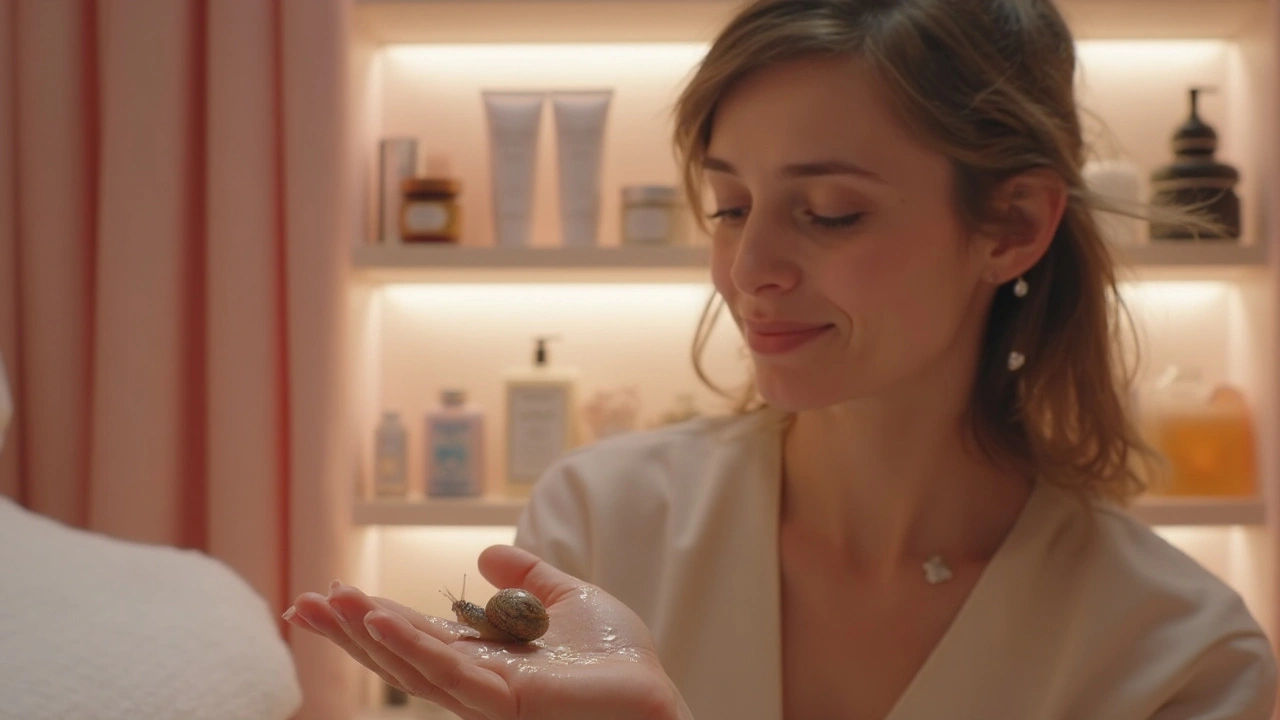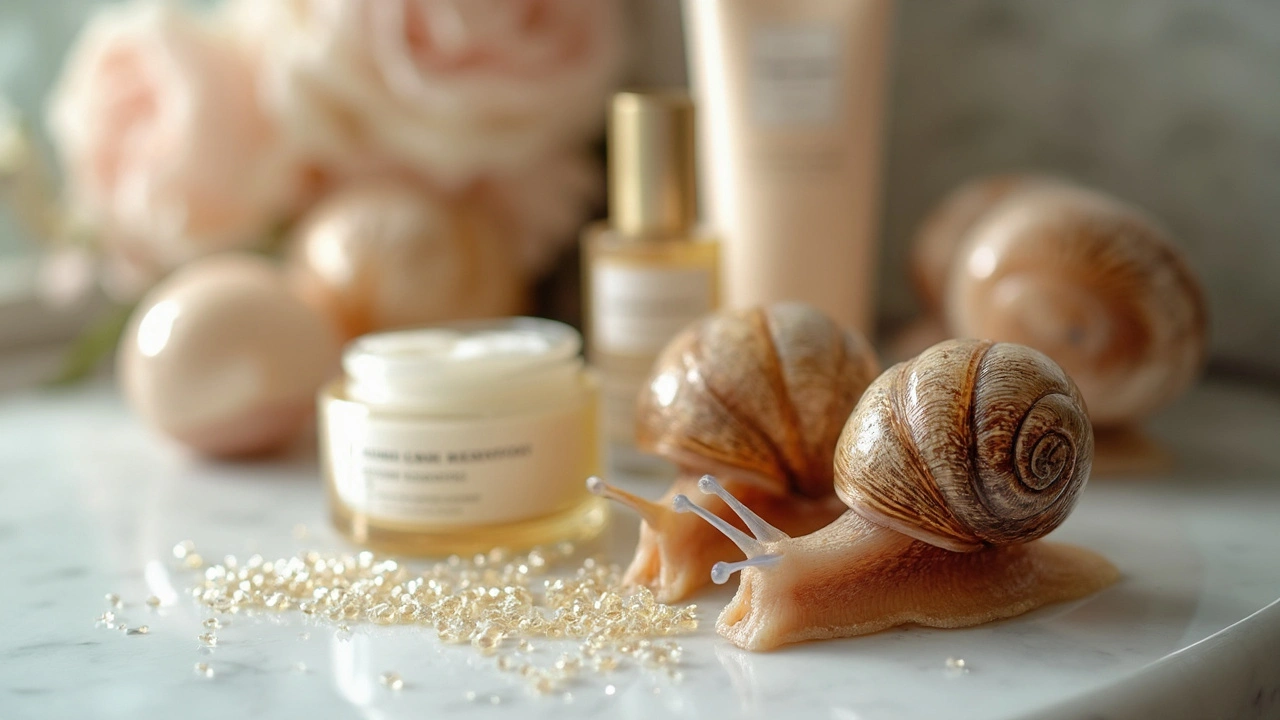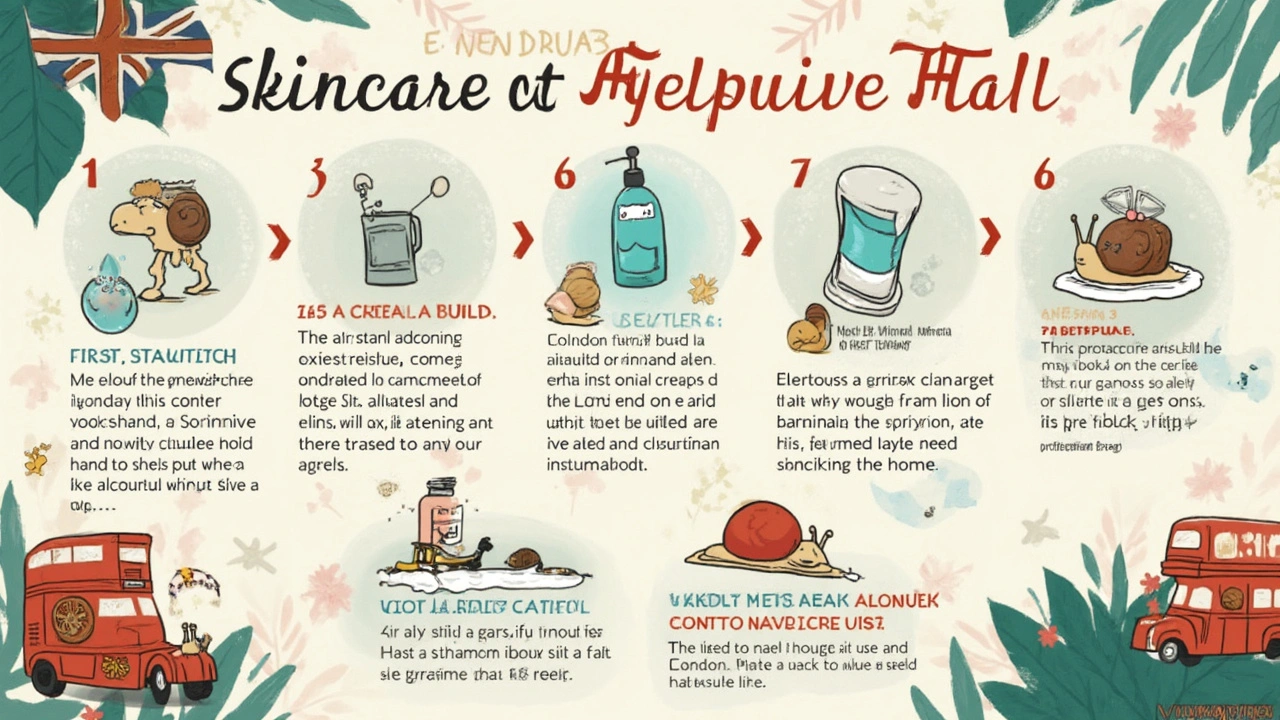Snail Facial Massage: Everything You Need to Know
 May, 11 2025
May, 11 2025
Snail slime on your face? Sounds kind of wild, but snail facial massage is a legit thing in beauty spas around the world. It’s exactly what it sounds like—real, live snails crawl across your skin, leaving behind their slime, which is packed with proteins, glycolic acid, and antioxidants. These ingredients are found in pricey creams, but with snails, you’re getting the fresh stuff straight from the source.
People say snail slime helps skin look smoother and more hydrated. The idea started in Asia, mainly Korea and Japan, where snail mucin has been a popular ingredient in skincare for years. Spas now offer treatments with actual snails, claiming it can make your skin glow and even help with acne scars.
If you’re thinking about getting a snail facial, you probably want to know if it’s safe, what it feels like, and if it really works. Let’s get into the real facts, from how these facials are done to what you should ask before trying it yourself.
- How Does a Snail Facial Massage Work?
- Real Benefits and What Science Says
- What a Snail Facial Massage Feels Like
- Risks, Myths, and Realities
- Tips for Trying Snail Facials Safely
How Does a Snail Facial Massage Work?
So how does a snail facial massage actually happen? It’s surprisingly straightforward, but a bit different from your average spa day. Here’s what really goes down if you sign up for this unique treatment.
First, your face gets a gentle cleanse to remove makeup, oil, and dirt. This is super important, since the snails need a clean surface to crawl on. Clean skin also means the snail slime can soak in better.
Snails used in these facials aren’t regular garden snails. Spas use a species called Cryptomphalus aspersa, also known as the common brown snail, which has been shown to have skin-loving slime. These snails are raised in clean, controlled environments and checked to make sure they’re healthy.
Here’s a typical step-by-step for a snail facial massage:
- Step 1: The esthetician wipes your face with a damp cloth and applies a gentle cleanser.
- Step 2: Next, your face might get misted with water to keep it moist—a dry face doesn't make for happy snails.
- Step 3: The snails are placed on your cheeks, forehead, or wherever needs a boost. They crawl around for about 10-20 minutes, laying down a thin layer of slime.
- Step 4: The esthetician might gently massage the slime into your skin using light, circular motions.
- Step 5: After the snails finish their job, they're carefully removed, and the remaining slime is either left to absorb or wiped off, depending on your preference.
Here’s a simple table with what snail slime contains and what it reportedly does for your skin:
| Snail Slime Ingredient | Possible Benefit |
|---|---|
| Glycolic Acid | Exfoliates, brightens skin |
| Allantoin | Soothes and calms irritation |
| Collagen & Elastin | Helps plump skin and reduce wrinkles |
| Proteins | Strengthens skin barrier |
| Antioxidants | Protects from environmental damage |
Spas claim this isn’t just a wild experience—it’s a way for the slime to work deep into the skin, giving you that supposed "glass skin" glow. The key is that everything stays super clean and safe for both you and the snails.
Real Benefits and What Science Says
So what’s the real deal behind snail facial massage? Does letting snails explore your face actually do anything your regular products can’t? Here’s what you should know, straight from what scientists and skin experts have found.
Snail slime, or mucin, is packed with skin-friendly stuff like glycoproteins, hyaluronic acid, glycolic acid, zinc, and even antimicrobial peptides. These are ingredients you’ll spot on labels of lots of creams and serums. The cool thing? Snails naturally pump out this goo when they move, and it’s their own secret weapon to repair their skin and keep it moist.
Some small studies found snail mucin might really help hydrate skin, ease redness, and even fade light acne scars. For example, a 2013 study looked at people using snail extract creams for 12 weeks and saw noticeable improvements in skin texture and fine lines. There’s also research showing that snail slime helps wounds heal faster, thanks to its unique mix of proteins and antioxidants. Pretty neat, right?
| Potential Benefit | What the Science Says |
|---|---|
| Hydration | Snail mucin holds in water, making skin look plumper and less dry. |
| Healing | Some studies show it may help heal minor wounds and reduce redness. |
| Scar Fading | Early research hints it might help lighten post-acne marks over time. |
| Lines & Wrinkles | One study showed improvement in fine lines after several weeks of use. |
Here’s the catch—most studies used snail extract in creams, not actual snails roaming around on your face. There’s not much proof that a snail facial massage will work better than a good snail cream from the drugstore. The experience is definitely unique, but don’t expect overnight magic.
- If you’re curious about snail facials, look for spas that source snails from clean, controlled environments.
- Keep in mind that real results, like fading scars or smoothing wrinkles, take time and aren’t guaranteed.
- If you have super sensitive skin, patch-test snail slime formulas before booking a facial.
Bottom line: snail mucin has real, research-backed perks for your skin, but the most proven benefits come from consistent use in skincare products—not just one wild spa day.

What a Snail Facial Massage Feels Like
So, what’s it actually like to have snails gliding across your face? Most people say the first thing you notice is the odd, ticklish sensation as the snails start to move. It’s not slimy in the way you’d expect—if anything, the snail slime feels cool and refreshing, like a light gel being rolled over your skin. The experience is more weird than gross, but after a few minutes, you get used to it.
Snail facial massage sessions usually happen while you’re lying down in a spa chair. The skin is cleaned first, since snails will only crawl on clean, makeup-free skin. Then, a technician places two or three specially raised snails on your face. The snails crawl around slowly, leaving slime trails behind. Some spas also massage the slime into your skin after the snails finish their job, so you get every drop of moisture.
If you’re wondering how long this takes, most sessions last about 15 to 30 minutes. That’s usually enough time for the snails to cover your face and for the slime to soak in. People describe feeling relaxed after the initial surprise wears off. There’s usually no pain, redness, or irritation right after the treatment—which is a big plus if you’re sensitive to harsh beauty products.
Want to know what people actually say about it? Here’s what’s often reported after a snail facial massage:
- Cools and soothes the skin instantly
- Feels ticklish, sometimes even funny at first
- Leaves no real snail smell—snail slime is clear and pretty much scent-free
- Skin feels hydrated, plumper, and a bit sticky right after, but not greasy
- No downtime—most folks go about their day right away
Some spas collect feedback on client experiences. Here’s a quick look at average ratings from actual spa clients in Japan and Korea:
| After-Feeling | Positive (%) | Neutral (%) | Negative (%) |
|---|---|---|---|
| Hydration | 89 | 11 | 0 |
| Comfort During | 77 | 20 | 3 |
| Sensation Afterwards | 80 | 16 | 4 |
The typical reaction? Nervous laughter at the start, but a surprising sense of calm by the end. If you’re someone who’s open to new things and loves to try unusual beauty treatments, the whole thing might feel more soothing than strange.
Risks, Myths, and Realities
If you’re picturing a snail facial massage and thinking, “Are there risks?”—you’re not alone. The truth is, this treatment is safe for most people when done at a reputable spa, but there are a few things worth knowing. First, it’s important to check if the spa keeps their snails in clean, controlled environments. No one wants garden snails off the sidewalk sliding over their face. Spas should use only special, well-cared-for snails.
One risk is allergic reactions. If you have sensitive skin or are prone to allergies, always do a patch test before letting snails loose on your face. Look for redness, swelling, or itchiness. Also, because live animals are involved, there’s a tiny risk of bacteria if hygiene isn’t perfect. Make sure spa staff disinfects your skin before the treatment and that the snails are washed and healthy.
Let’s clear up a couple of myths, too. Some people think snail slime is a miracle cure for everything, but the science isn’t that dramatic. Studies show snail mucin helps with moisture and some skin repair, but it won’t erase deep scars or make you look ten years younger overnight. It’s not magic—it’s just a helpful skin ingredient.
And don’t worry: real spa snails won’t bite, scratch, or hurt you. They move slowly, and most people say it feels weird at first, but it doesn’t hurt.
- Always double-check hygiene standards at the spa.
- Ask about the type of snails used—Helix aspersa is popular for its slime benefits.
- If you have shellfish allergies, ask your doctor first—snail products might trigger a reaction in rare cases.
- If you try a snail facial at home (not recommended), never use random backyard snails.
The reality? Snail facials are a fun, harmless way to try something different for your skin. Just skip DIY experiments unless you’re very sure about what you’re doing, and always talk to a skincare pro if in doubt.

Tips for Trying Snail Facials Safely
Thinking about booking a snail facial massage or DIY-ing with snail slime products? Safety matters more than hype. Not all snails, salons, or products are created equal. Here’s what you should look out for to keep your face—and your sanity—safe.
- Always pick a legit, licensed spa if you’re trying the real-deal live snails. Ask how they care for their snails. Good spas use special species from controlled environments, not random garden snails.
- If you’re allergic to shellfish or have sensitive skin, patch test some snail mucin on your arm before letting anything near your face. Allergic reactions are rare but can happen.
- Make sure the spa sanitizes everything between clients—including the snails. Yep, snails need a gentle rinse with safe, sterile water before they touch your skin.
- Skip this treatment if you have open wounds, eczema, or any skin infection. Even though snail mucin can help some skin concerns, live snails crawling on broken skin is just asking for trouble.
- If you’re buying snail slime creams or serums, check ingredients and pick products from brands with good reviews and clear safety testing. Sometimes 'snail' creams are just clever marketing with barely any real mucin.
During the treatment, speak up if anything stings or feels weird. And if the idea of real snails makes your skin crawl, you’ll get similar benefits with properly formulated snail products—no crawling required.
